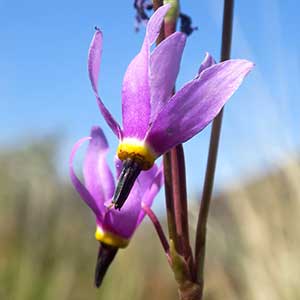Dodecatheon conjugens
Dodecatheon meadia
Bonneville shooting star, desert shootingstar, slim-pod shooting star
pride-of-Ohio
not obvious at anthesis;
roots whitish;
bulblets absent.
not obvious at anthesis;
roots whitish to tan or brownish;
bulblets absent.
3–13(–18) × 0.7–2.5(–4) cm;
petiole slender (at least proximally);
blade narrowly oblanceolate to spatulate or obovate, base usually not decurrent onto stem, usually abruptly tapering to petiole, margins entire, surfaces glabrous or glandular-puberulent.
8–30 × 2–8 cm;
petiole winged;
blade (usually suffused with red at base even when dry), usually oblanceolate to oblong or spatulate, rarely ovate, base decurrent onto stem, gradually tapering to petiole, margins usually entire, rarely coarsely toothed, surfaces glabrous.
1–7(–10)-flowered;
bracts lanceolate to broadly lanceolate, 3–10 mm, glandular-puberulent.
1–25(–125)-flowered;
bracts lanceolate, 3–10 mm, usually glabrous, rarely glandular-pubescent.
1–5 cm, glabrous or glandular-puberulent.
(1.5–)3–7 cm, usually glabrous, rarely glandular-pubescent.
calyx light green to yellowish, sometimes finely purple-speckled or -dotted, 5–12 mm, glabrous or glandular-puberulent, tube 2–6 mm, lobes 5, 3–7 mm;
corolla tube yellowish with purplish red, thin, wavy ring, lobes 5, usually magenta, sometimes white, 7–25(–35) mm;
filaments usually distinct, yellowish or dark maroon, 0.5–1.5 mm, rarely partially connate and tube 0.5–1.5 × 1.5–5 mm;
anthers 5–9 mm;
pollen sacs usually maroon or yellow, sometimes yellowish and speckled maroon, rarely with reddish purple to purple speckles, connective usually maroon, sometimes yellowish or light blue to whitish, transversely rugose;
stigma not enlarged compared to style.
calyx light green to green, 5–12 mm, glabrous, tube 2–3.8 mm, lobes 5, (2.5–)3–7(–9) mm;
corolla tube maroon and yellow with dark maroon, ± thick, wavy ring, lobes 5, white or lavender to magenta, (10–)12–25(–27) mm;
filaments usually connate, tube yellow, 0.5–3 × 1–2 mm;
anthers (4–)5.5–10 mm;
pollen sacs yellow, sometimes speckled with red or maroon, connective purple, dark maroon, or black, smooth;
stigmas not enlarged compared to style.
tan, often striped with purple, usually operculate, rarely valvate, cylindric-ovoid, 8–17(–22) × 4–6(–8) mm, glabrous;
walls thin, pliable.
dark reddish brown, valvate, cylindric-ovoid, 7–18(–21) × 4–6(–9) mm, glabrous;
walls thick, firm.
without membrane along edges.
without membrane along edges.
= 44.
= 88.
Dodecatheon conjugens
Dodecatheon meadia
Varieties 2 (2 in the flora).
Both Dodecatheon conjugens and D. poeticum occur in proximity in the Columbia River gorge. Some specimens here assigned to var. conjugens may have scattered, minute glands on the pedicels that might indicate past hybridization with D. poeticum (e.g., G. N. Jones 6286, ORE; R. R. Halse 3790, OSC, WTU). Dodecatheon poeticum is densely glandular not only on the pedicels, but also on the calyx and scape. The type of minute glandular puberulence seen on var. conjugens found along the Columbia River west of The Dalles is somewhat similar to that seen on var. viscidum in western Montana and Canada. Some plants referred here to D. conjugens have slightly connate filaments that may indicate some intergradation with D. pulchellum var. pulchellum. This suggestion is supported by the tendency in the same plants to have narrower leaves.
Some newly emerged flowers tend to have connectives that are less rugose than normal. This is particularly true of some populations in southern Alberta and, to a lesser degree, in Saskatchewan.
(Discussion copyrighted by Flora of North America; reprinted with permission.)
Dodecatheon meadia is widespread and highly variable. Many segregate species and infraspecific entities have been proposed. Except for recognizing D. frenchii (a diploid), partitioning D. meadia (a tetraploid) into finer units as done by N. C. Fassett (1944) is unrealistic. It has been traditional to distinguish at least two varieties. The typical variety is mainly a plant of the north and east with anthers 6.5–10 mm, capsules 10–18(–21) mm, calyx lobes 4–8 mm, and corolla lobes 12–20 mm. To the south and west (mainly Missouri, eastern Oklahoma, eastern Texas, and Arkansas to northwest Alabama, Tennessee, and Virginia) plants with anthers 4–7(–8) mm, capsules 7–10 mm, calyx lobes 3–5 mm, and corolla lobes 10–15 mm occur; these have been termed var. brachycarpum. A distinction is not made here because both entities are sometimes found growing together, and each can be found, often as individual plants, well outside its expected range. Flower color varies in a different pattern. Most of the southern populations of D. media have white petals; those of the north (including the Linnaean type) have lavender to magenta petals. Throughout the range, petals are sometimes more pinkish or are white with a tinge of purple. In southern Missouri and northern Arkansas are plants with alabaster white petals. All too often, a single population will vary in petal color, making a taxonomic distinction dubious. Plants with ovoid capsules 9–10 × 4–9 mm occur in Alabama; these were named var. obesum Fassett. Although the ovoid condition appears to be restricted geographically, it is doubtful that it diagnoses a well-marked variety.
Dodecatheon meadia is locally common in some areas; on its geographical edges, it is often rare and thus of local concern to some state heritage programs. The species is commonly cultivated and numerous cultivars have been developed.
(Discussion copyrighted by Flora of North America; reprinted with permission.)
1. Leaf blades, scapes, and pedicels glabrous. | var. conjugens |
1. Leaf blades, scapes proximally, and pedicels usually glandular-puberulent. | var. viscidum |
- Local floras:
BC,
CA,
OR,
WA
- Local Web sites:
CalFlora,
CalPhotos,
Flora NW,
PNW Herbaria,
Turner Photog.
WildflowerSearch
iNaturalist (observations)
USDA Plants Database
- LBJ Wildflower Center
- SEINet
- Plants of the World Online
- Encyclopedia of Life
- Wikipedia
- Google Image Search
